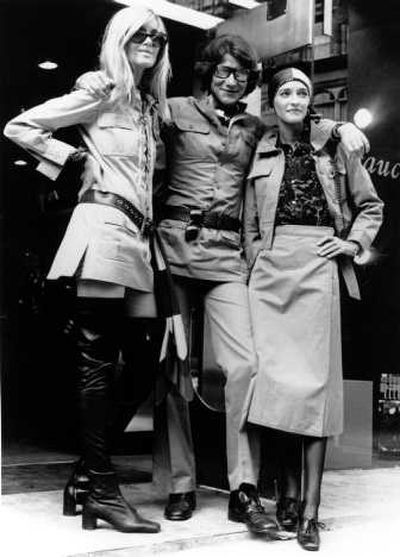Saint Laurent, legendary fashion designer, dies at 71

PARIS – Legendary designer Yves Saint Laurent, who reworked the rules of fashion by putting women into elegant pantsuits that came to define how modern women dressed, died Sunday evening, a longtime friend and associate said. He was 71.
Pierre Berge, Saint Laurent’s business partner for four decades, said he had died at his Paris home following a long illness.
A towering figure of 20th century fashion, Saint Laurent was widely considered the last of a generation that included Christian Dior and Coco Chanel, and made Paris the fashion capital of the world, with the Rive Gauche, or Left Bank, as its elegant headquarters.
In the fast-changing world of haute couture, Saint Laurent was hailed as the most influential and enduring designer of his time. From the first YSL tuxedo and his trim pantsuits to see-through blouses, safari jackets and glamorous gowns, Saint Laurent created instant classics that remain stylish decades later.
Berge praised Saint Laurent as the man who marked “the second half of the 20th century” in fashion.
“Chanel gave women freedom” in the first half, and Saint Laurent “gave them power,” he said on France-Info radio. Saint Laurent was a “true creator,” going beyond the aesthetic to make a social statement, Berge said.
“In this sense he was a libertarian, an anarchist, and he threw bombs at the legs of society. That’s how he transformed society and that’s how he transformed women.”
When Saint Laurent announced his retirement in 2002 at 65 and the closure of the Paris-based haute couture house he had founded 40 years earlier, it was mourned in the fashion world as the end of an era. His ready-to-wear label – Rive Gauche, which was sold to Gucci in 1999 – still has boutiques around the world.
Saint Laurent was born Aug. 1, 1936, in Oran, Algeria, where his father worked as a shipping executive. He first emerged as a promising designer at the age of 17, winning first prize in a contest sponsored by the International Wool Secretariat for a cocktail dress design.
A year later in 1954, he enrolled at the Chambre Syndicale school of haute couture, but student life lasted only three months. He was introduced to Christian Dior, then regarded as the greatest creator of his day, and Dior was so impressed with Saint Laurent’s talent that he hired him on the spot.
When Dior died suddenly in 1957, Saint Laurent was named head of the House of Dior at the age of 21. The next year his first solo collection for Dior – the “trapeze” line – launched Saint Laurent’s stardom. The trapeze dress – with its narrow shoulders and wide, swinging skirt – was a hit, and a breath of fresh air after years of constructed clothing, tight waists and girdles.
In 1960, Saint Laurent was drafted into military service – an experience that shattered the delicate designer, who by the end of the year was given a medical discharge for nervous depression.
Bouts of depression marked his career. Berge, the designer’s longtime business partner and former romantic partner, was quoted as saying that Saint Laurent was born with a nervous breakdown.
Saint Laurent returned to the spotlight in 1962, opening his own haute couture fashion house with Berge. The pair later started a chain of Rive Gauche ready-to-wear boutiques.
Life magazine hailed his first line under his own label as “the best collection of suits since Chanel.”
Nowhere was Saint Laurent’s gift more evident than the valedictory fashion show that marked his retirement in January 2002.
There was the simple navy blue pea coat over white pants, which the designer showed in 1962 when he opened his couture house and kept as one of his hallmarks.
His “smoking,” or tuxedo jacket, of 1966 remade the tux as a high fashion statement for both sexes. It remained the designer’s trademark item and was updated yearly until he retired.
Also from the ‘60s came Beatnik chic – a black leather jacket and knit turtleneck with high boots – and sleek pantsuits that underlined Saint Laurent’s statement on equality of the sexes. He showed that women could wear “men’s clothes,” which when tailored to the female form became an emblem of elegant femininity.
Saint Laurent said, “Fashion was not only supposed to make women beautiful, but to reassure them, to give them confidence, to allow them to come to terms with themselves.”